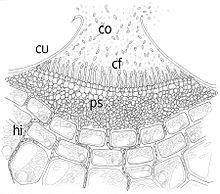
Acervulus morphology.
cu: cuticle, co: conidium, cf: conidiophore, ps: pseudo-parenchymatic stroma, hi: hypha.
An acervulus (pl. acervuli) is a small asexual fruiting body that erupts through the epidermis of host plants parasitised by mitosporic fungi of the form order Melanconiales (Deuteromycota, Coelomycetes). It has the form of a small cushion at the bottom of which short crowded conidiophores are formed. The spores escape through an opening at the top.
Sources
- Trigiano, Robert Nicholas, Mark Townsend Windham, Alan S. Windham. (2004) Plant Pathology: Concepts and Laboratory Exercises. CRC Press. pp. 11,129,137.
This article is copied from an
article on Wikipedia® - the free encyclopedia created and edited by its online user community. The text was not checked or edited by anyone on our staff. Although the vast majority of Wikipedia® encyclopedia articles provide accurate and timely information, please do not assume the accuracy of any particular article. This article is distributed under the terms of
GNU Free Documentation License.
All content on this website, including dictionary, thesaurus, literature, geography, and other reference data is for informational purposes only. This information should not be considered complete, up to date, and is not intended to be used in place of a visit, consultation, or advice of a legal, medical, or any other professional.
